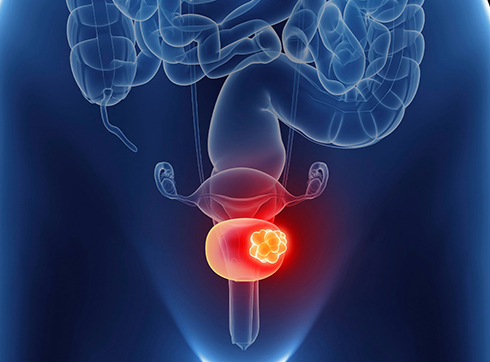
Bladder cancer is a malignant neoplasm, a tumor that occurs in the lining of the bladder. The tumor can grow into neighboring organs and tissues of the small pelvis and affect the urethra, tissue of the uterus or prostate gland, rectum. It can also metastasize to other organs for example, in the bones, lungs, liver, and even the brain.
Classification of bladder tumors
Tumors that affect the bladder can be benign or malignant. The first are papillomas. This is a soft tumor on the leg, which consists of many stretching "villi". It can degenerate into a malignant tumor, therefore it must be removed. The operation is usually performed endoscopically.
By the type of cells from which the tumor is formed, there are different types of bladder cancer. Transitional cell carcinoma (also urothelial carcinoma) is the most common, accounting for 90% of cases. Other types, such as adenocarcinoma, small cell carcinoma, squamous cell carcinoma of the bladder, or sarcoma (tumor of connective tissue cells) are much less common.
The most dangerous are malignant tumors of the bladder - papillary and infiltrating cancer. According to statistics, they develop in men four times more often than in women. The most at risk age group is 40–60 years.
Bladder tumors can be non-invasive (do not grow beyond the epithelium), invasive (grow into other layers of the bladder and beyond), metastatic (arising from metastases of a tumor in another organ).
By the type of growth, bladder tumors are exophytic (in the form of a polyp on the bladder wall), endophytic (in the form of a seal inside the bladder wall), mixed (grow both inside the wall and outside).
Stages of bladder cancer
- Stage 1 - the tumor occupies only the mucous membrane of the bladder, it does not grow into other layers of the organ and does not metastasize;
- Stage 2 - a malignant tumor grows into other layers of the bladder, but does not go beyond the organ;
- Stage 3 - the tumor affects tissues adjacent to the bladder;
- Stage 4 - a malignant tumor of the bladder gives metastases.
The TNM system assesses three indicators of a malignant tumor to determine the stage of bladder cancer:
- T is the degree of invasion of the tumor: Ta is a small non-invasive bulging tumor that remains within the epithelium Tis is a small non-invasive squamous tumor that does not invade other layers of the bladder T1 corresponds to stage 1 bladder cancer when the tumor is shed outside the epithelium, T2 (or stage 2) - the tumor affects the muscle layer of the bladder, T3 (or stage 3) - the tumor grows into the connective tissue, T4 (stage 4) - the tumor spreads to neighboring organs of the small pelvis;
- N - the number of affected regional lymph nodes: N0 - lymph nodes are not affected, N1 - bladder tumor metastases are present in one lymph node, N2 - in several regional lymph nodes, N3 - in distant lymph nodes.
- M - presence of distant metastases, M0 - no distant metastases, M1 - presence of distant metastases.
Causes of bladder cancer
Thoroughly the etiology of bladder cancer has not been studied. But it is safe to say that the risk of its development is associated with smoking and exposure to various chemical or biological carcinogens. It depends on the structural features of the organ. The bladder performs a cumulative function, so the products dissolved in the urine can act on its walls for some time. Among chemical carcinogens, substances used in rubber, paint and varnish, paper production are distinguished. Of the food can be noted fried meat, fat of animal origin, foods with a high content of vitamin A.
The reason for the development of a malignant tumor can also be previously transferred radiation therapy, which was used, for example, in the treatment of cancer of the ureters. A predisposing factor is the use of cyclophosphamide in therapy.
A malignant formation can develop in the presence of chronic cystitis or a parasitic lesion - schistosomiasis.
Risk factors also include:
- age over 55;
- male;
- frequent urinary retention;
- genetic predisposition;
- bladder cancer; diagnosed in relatives;
- some concomitant diseases (cystitis; diverticula; urolithiasis; others);
- sexual infections (gonorrhea; chlamydia; mycoplasmosis; papillomavirus; others);
- bad ecology;
- excessive chlorination and fluoridation of water;
- radiotherapy; which was used to treat ovarian and uterine cancer;
- sitting for a long time.
Prevention of bladder cancer
To prevent the development of malignant tumors and bladder cancer, experts advise to drink more fluids, get rid of bad habits, not to endure when you want to go to the toilet, avoid benzidine dyes and contact with other harmful substances, and undergo an annual medical examination with a urologist.
The earlier a tumor in the bladder is detected, the more optimistic the prognosis of treatment is. Greater chance of success when bladder cancer is in its early stages. Therefore, you need to regularly visit a urologist and undergo diagnostics.
Symptoms of bladder cancer
The primary symptom of bladder cancer is blood in the urine. No pain is observed. This symptom does not always mean exactly oncological problems, but you can’t hesitate and you need to urgently sign up for a diagnosis with a urologist, even if the urine is slightly colored pink. At the same time, such staining, the appearance of drops of blood in the urine, may appear once, and then for months the color of the urine is normal. One of the first symptoms of bladder cancer can also be enlarged lymph nodes in the groin.
Other symptoms of the presence of malignant tumors in the bladder may be non-specific and coincide with the symptoms of other diseases. This may include frequent urination, pain during urination, a weak stream, or other urinary problems.
If the tumor has already grown deep into the wall of the bladder, then it can cause compression of the ureters. This will lead to the development of kidney failure. In this case, the patient may begin to be disturbed by pain in the lumbar region. But correct diagnosis is important here. Similar symptoms are observed in kidney cancer.
With the progression of the disease and the lack of proper treatment, others join the symptoms described above:
- difficult, often painful urination;
- pain in the lower abdomen that radiates to the perineum;
- imperative urge to urinate;
- weakness;
- lack of appetite;
- weight loss;
- swelling on the legs;
- bone pain.
Many of these symptoms are not necessarily signs of bladder cancer. They may indicate the presence of other diseases, for example, prostate adenoma or urolithiasis, cystitis, etc.
Features of bladder cancer in women
The symptoms of bladder cancer in women do not differ from those in men. But women are less likely than men to react with fear to blood in the urine, especially if it appeared before menstruation. Therefore, they go to the clinic less often and are examined later, and this disease is diagnosed at later stages. But bladder cancer is less common in women than in men. And, as a rule, these are less aggressive forms of malignant tumors and with a lesser degree of invasion. But in the advanced stages of bladder cancer, women have a slightly higher mortality rate than men.
Features of malignant tumors in the bladder in men
Bladder cancer is more common in men. And at an earlier age than women. The malignant tumor itself is more aggressive and more invasive (it often grows into adjacent layers of the bladder, and then into neighboring organs and tissues of the genitourinary system). And the symptoms of bladder cancer in men can be disguised as prostate adenoma.









































